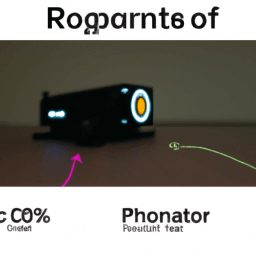Understanding Projector Contrast Ratio What You Should Know?
Projector contrast ratio refers to the difference between the darkest and brightest parts of an image. A higher contrast ratio means a better image quality with more detail and depth. It is important to understand that contrast ratio is not the same as brightness, as a projector with high brightness but low contrast ratio can still produce a washed-out image. When choosing a projector, it is recommended to look for a contrast ratio of at least 1000:1. However, it is important to note that contrast ratio measurements can vary between manufacturers, so it is best to compare multiple projectors before making a decision.
Understanding Projector Contrast Ratio: What You Should Know?
When it comes to buying a projector, one of the most important factors to consider is the contrast ratio. The contrast ratio is a measure of the difference between the darkest and brightest parts of an image. In simple terms, it is the ratio of the brightest white to the darkest black that a projector can produce.
What is Contrast Ratio?
The contrast ratio is a measure of the difference between the brightest and darkest parts of an image. It is usually expressed as a ratio, such as 1000:1 or 2000:1. The first number represents the brightness of the brightest part of the image, while the second number represents the brightness of the darkest part of the image.
For example, a projector with a contrast ratio of 1000:1 can produce an image where the brightest part of the image is 1000 times brighter than the darkest part of the image. A projector with a higher contrast ratio will be able to produce a more vibrant and dynamic image, with deeper blacks and brighter whites.
Why is Contrast Ratio Important?
The contrast ratio is an important factor to consider when buying a projector because it directly affects the quality of the image that the projector can produce. A projector with a high contrast ratio will be able to produce a more vibrant and dynamic image, with deeper blacks and brighter whites.
On the other hand, a projector with a low contrast ratio will produce a dull and washed-out image, with poor color saturation and detail. This is because the projector is not able to produce a wide range of brightness levels, which means that the image will lack contrast and depth.
How to Choose the Right Contrast Ratio?
When choosing a projector, it is important to consider the environment in which it will be used. If you are using the projector in a dark room, a high contrast ratio will be more important than if you are using it in a bright room.
For example, if you are using the projector in a dark home theater room, a contrast ratio of at least 2000:1 is recommended. This will ensure that the blacks are deep and the whites are bright, which will result in a more immersive viewing experience.
On the other hand, if you are using the projector in a bright conference room, a contrast ratio of at least 1000:1 is recommended. This will ensure that the image is bright enough to be seen clearly in a well-lit room.
Conclusion
The contrast ratio is an important factor to consider when buying a projector. It directly affects the quality of the image that the projector can produce. A projector with a high contrast ratio will be able to produce a more vibrant and dynamic image, with deeper blacks and brighter whites. When choosing a projector, it is important to consider the environment in which it will be used and choose a contrast ratio that is appropriate for that environment.
| Projector | Contrast Ratio | Price |
|---|---|---|
| Epson Home Cinema 2150 | 60,000:1 | $799.99 |
| Optoma HD143X | 23,000:1 | $449.99 |
| BenQ HT2050A | 15,000:1 | $749.00 |
| ViewSonic PX747-4K | 12,000:1 | $999.99 |
| LG CineBeam HU80KA | 150,000:1 | $2,699.99 |
| By www.zelect.in | ||
Sharing is caring!
Facebook Twitter Email
Recommended articles for Projector
Projector types and buying guide
-
Understanding Projector Refresh Rate: What You Need to Know
-
The Benefits of 4K Projectors: Crisp and Detailed Image Quality
-
What is HDR projector? What are the advantages and disadvantages of HDR projectors?
-
The Advantages of Ultra-Short Throw Projectors
-
Projector Screen Size Guide: Selecting the Perfect Dimensions
-
What is DLP projector? What are the advantages and disadvantages of DLP projectors?
-
What is ultra short throw projector? What are the advantages and disadvantages of ultra short throw projectors?
-
What is a short throw projector? What are the advantages and disadvantages of LCD projectors?
-
Choosing the Right Projector Mount: Ceiling or Wall?
-
Projector Image Quality: Factors to Consider
-
Projector vs. Smart TV: Which is the Better Entertainment Option?
-
What is LED projector? What are the advantages and disadvantages of LED projectors?
-
What is hologram projector? What are the advantages and disadvantages of hologram projectors?
-
What is a laser projector? What are the advantages and disadvantages of laser projectors?
-
Projector buying guide. How to Choose the Right projector for your needs?
-
Understanding Projector Throw Ratio and Image Size
-
Projector Keystone Correction: What is it and How to Use it
-
The Rise of Laser Projectors: Advantages and Limitations
-
Projector Screens: Which Type is Right for You?
-
Projector vs. TV pros and cons. Which is the Better Option?
-
A Comprehensive Guide to Projector Lumens and Brightness?
-
What are the advantage and disadvantage of projector?
-
Understanding Projector Contrast Ratio What You Should Know?
-
Compare projector contrast ratio vs lumens
-
How many lumens is best for projector during day?
-
What is lumens in projector?
-
What is the best projector type?
-
What are the different types of projectors? Their uses?


